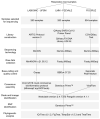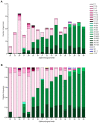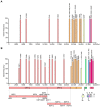Introduction, Dispersal, and Predominance of SARS-CoV-2 Delta Variant in Rio Grande do Sul, Brazil: A Retrospective Analysis
- PMID: 38138081
- PMCID: PMC10745878
- DOI: 10.3390/microorganisms11122938
Introduction, Dispersal, and Predominance of SARS-CoV-2 Delta Variant in Rio Grande do Sul, Brazil: A Retrospective Analysis
Abstract
Mutations in the SARS-CoV-2 genome can alter the virus' fitness, leading to the emergence of variants of concern (VOC). In Brazil, the Gamma variant dominated the pandemic in the first half of 2021, and from June onwards, the first cases of Delta infection were documented. Here, we investigate the introduction and dispersal of the Delta variant in the RS state by sequencing 1077 SARS-CoV-2-positive samples from June to October 2021. Of these samples, 34.7% were identified as Gamma and 65.3% as Delta. Notably, 99.2% of Delta sequences were clustered within the 21J lineage, forming a significant Brazilian clade. The estimated clock rate was 5.97 × 10-4 substitutions per site per year. The Delta variant was first reported on 17 June in the Vinhedos Basalto microregion and rapidly spread, accounting for over 70% of cases within nine weeks. Despite this, the number of cases and deaths remained stable, possibly due to vaccination, prior infections, and the continued mandatory mask use. In conclusion, our study provides insights into the Delta variant circulating in the RS state, highlighting the importance of genomic surveillance for monitoring viral evolution, even when the impact of new variants may be less severe in a given region.
Keywords: genome analysis; genomic surveillance; phylogeny; variants of concern; viral lineages.
Conflict of interest statement
The authors declare no conflict of interest. The funders had no role in the design of the study; in the collection, analyses, or interpretation of data; in the writing of the manuscript; or in the decision to publish the results.
Figures







Similar articles
-
Higher frequency of interstate over international transmission chains of SARS-CoV-2 virus at the Rio Grande do Sul - Brazil state borders.Virus Res. 2025 Jan;351:199500. doi: 10.1016/j.virusres.2024.199500. Epub 2024 Dec 17. Virus Res. 2025. PMID: 39645167 Free PMC article.
-
Early introduction, dispersal and evolution of Delta SARS-CoV-2 in Southern Brazil, late predominance of AY.99.2 and AY.101 related lineages.Virus Res. 2022 Apr 2;311:198702. doi: 10.1016/j.virusres.2022.198702. Epub 2022 Jan 29. Virus Res. 2022. PMID: 35104582 Free PMC article.
-
Genomic Surveillance of SARS-CoV-2 Lineages Indicates Early Circulation of P.1 (Gamma) Variant of Concern in Southern Brazil.Microbiol Spectr. 2022 Feb 23;10(1):e0151121. doi: 10.1128/spectrum.01511-21. Epub 2022 Feb 16. Microbiol Spectr. 2022. PMID: 35171035 Free PMC article.
-
Emergence and Spread of the SARS-CoV-2 Variant of Concern Delta across Different Brazilian Regions.Microbiol Spectr. 2022 Oct 26;10(5):e0264121. doi: 10.1128/spectrum.02641-21. Epub 2022 Aug 24. Microbiol Spectr. 2022. PMID: 36000897 Free PMC article.
-
Molecular evolution of SARS-CoV-2 from December 2019 to August 2022.J Med Virol. 2023 Jan;95(1):e28366. doi: 10.1002/jmv.28366. J Med Virol. 2023. PMID: 36458547 Free PMC article. Review.
Cited by
-
Higher frequency of interstate over international transmission chains of SARS-CoV-2 virus at the Rio Grande do Sul - Brazil state borders.Virus Res. 2025 Jan;351:199500. doi: 10.1016/j.virusres.2024.199500. Epub 2024 Dec 17. Virus Res. 2025. PMID: 39645167 Free PMC article.
-
Unveiling the Dynamics of SARS-CoV-2 Gamma and Delta Waves in Paraná, Brazil - Delta Displacing a Persistent Gamma Through Alternative Routes of Dispersal.J Med Virol. 2025 Apr;97(4):e70318. doi: 10.1002/jmv.70318. J Med Virol. 2025. PMID: 40186553 Free PMC article.
References
-
- Cherian S., Potdar V., Jadhav S., Yadav P., Gupta N., Das M., Rakshit P., Singh S., Abraham P., Panda S. SARS-CoV-2 Spike Mutations, L452R, T478K, E484Q and P681R, in the Second Wave of COVID-19 in Maharashtra, India. Microorganisms. 2021;9:1542. doi: 10.3390/microorganisms9071542. - DOI - PMC - PubMed
-
- CoVariants Overview of Variants in Countries. [(accessed on 1 November 2023)]. Available online: https://covariants.org/per-country?variant=21A+%28Delta%29&variant=21I+%....
-
- World Health Organization Tracking SARS-CoV-2 Variants. [(accessed on 1 November 2023)]. Available online: https://www.who.int/publications/m/item/historical-working-definitions-a....
Grants and funding
- 88887.502716/2020-00 and 88882.461702/2019-01/Coordenação de Aperfeicoamento de Pessoal de Nível Superior
- FINEP grant 01.20.0029.000462/20, CNPq 404096/2020-4/Rede Corona-omica BR MCTI/FINEP affiliated to RedeVírus/MCTI
- 21/2551-0000081-3/FAPERGS
- 28186 and 28186*1/AstraZeneca
- 28098/Bill e Melinda Gates Foundation
LinkOut - more resources
Full Text Sources
Miscellaneous

